This blog post references pictures for Mark, Will, and Joe’s final project. Please do not delete this post or edit it at all. Thank you.


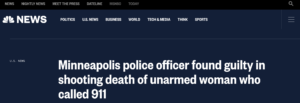
This blog post references pictures for Mark, Will, and Joe’s final project. Please do not delete this post or edit it at all. Thank you.



My visual representation of refugee/asylum seekers is the film Hotel Rwanda. A basic plot summary of the film is that it’s about a hotel manager who houses thousands of Tutsi refugees.
My article is focused on my ancestral home, Scotland’s, immigrants. More specifically, the article focuses on Scottish immigrants in Australian cities from 1880-1933, and how, “this article demonstrates that Scottish migrants in Australia at the turn of the twentieth century largely belonged to an urban industrial working class, and provides a useful correction to the traditional images of Scots in Australia as mostly rural, well-off, and conservative migrants,” (Wilkie 81).
Over time, it’s been argued that settlement patterns of Scots in Australia has been associated with employment opportunities, housing, lifestyle, and religious preferences. But their experiences entering Australia were not always good to start off with and wanting some wishing they could go back home to Scotland. But there were areas in Australia where family houses had been deserted and left open for the taking. It was minimal but enough to satisfy what the immigrants wanted: a portion of land to themselves. They were leaving behind cramped houses where families were living on top of each other, almost literally, to survive in the crowded country, making the change to Australia very different. The choice of housing does not seem to affect what church Scots went to for the main draw seems to be to head towards Presbyterian churches such as Dorcas Street Presbyterian Church and Sunday School. Scottish immigrants tend to work primarily in jobs they were familiar with like manufacturing and shipping and would get jobs by ports.
All in all, I found this article academic journal interesting because it gives a different look at immigration within another country at a different point in history.
Wilkie, Ben. “Lairds of Suburbia: Scottish Migrant Settlement and Housing in . Australian Cities, 1880-1930.” Journal of Scottish Historical Studies, 2016, 81-104.
My second article focuses on what happened in New Zealand but how the attacks on Donald Trump for being an inspiration to the killer, and the outlash against his behavior on the matter are wrong.
The man accused of the attack on the mosques in New Zealand stated that Donald Trump is a “symbol of renewed white identity…” while Trump made comments seeming to go with the accuser being innocent: “I didn’t see it. I didn’t see it. But I think it’s a horrible event…a horrible disgraceful thing and a horrible act.” However, the accused man of the New Zealand attack also stated Trump as a bad policy maker and leader.
The article then talks about how Trump has always been attacked for his views related to immigration constantly with the most notable being the border wall which he promised when running for president. Regarding the events in New Zealand, Trump took it upon himself to call the Prime Minster of New Zealand, Jacinda Ardern, and extend his condolences for what happening telling her the U.S. will do whatever it can to help.
The Democratic party still takes aim at Trump opposing his viewpoints on immigration, and for secretly supporting nationalists and the KKK. One of the last paragraphs takes about statistics relating to white nationalists stating that deaths by white supremacists have gone up from 37 to 50 from 2017 to 2018. Donald Trump views the situation as a small group of people doing some bad things, but not a major issue at the moment.

The article, in a quick summary, states that during Trump’s presidency, he has given White Supremacists comfort to come out from behind masks and view immigrants as the new threat.
The article talks about a tweet President Donald Trump made after the attack in New Zealand where he call out “Fake News Media” for blaming him for the attack in New Zealand. The writer, Felicia Persuad, argues that it is Trump’s fault for what has happened stating that he has given White Supremacists courage to come out and attack immigrants since the start of his presidency in 2016. The man accused of the murder of 50 immigrants in a Christ-Church mosque wrote in his manifesto that Trump is “a symbol of renewed white identity and common purpose.” With Trump making comments about “building the wall,” and banning Muslims from entering, he is giving White Supremacists gas to the fire, giving them a reason to hate. The article compares the sudden growth of hate groups as a growing terror that should be compared to ISIS. In 2017, FBI records indicate 7,175 hate crimes were reported across the U.S. with 34 being specifically from white supremacist groups. That would be about 20 hate crimes a day, not to mention social media bullying and harassment (specifically racist comments) have increased drastically.
The writer attacks the Trump administration for how it’s been running things since its inauguration in 2016. She states that the hate groups are not small but large and must be hunted down and note overlooked as Trump as done so far.
Every time I get a chance to meet someone who has experience in an industry I have an interest in is always nice. I don’t tend to talk and ask questions in big groups, just listen and digest responses. Carlos Hernandez does such a wide variety of media, it’s hard to fathom that he can do it with ease. I sometimes have trouble writing a screenplay but this man can do books, poems, video games, etc. A lot of what I gathered from his presentation was to get your work out there, and draw from what you know or like. You can’t find out what works until you try and get others to read it. Also hearing how he came up with some of this stories makes me think about my own stories I can write. As a film major with an interest in producing and screenwriting, I can use this idea to write more screenplays (features or shorts) and submit them to festivals to gain awareness.
My idea for an organization to work with is not one mentioned in class: Caring Hands Africa. The organization does mission trips to Africa to assist people in places such as Zimbabwe and Cameroon by offering medical assistance. The goal is to start a connection between Stevenson and the organization Caring Hands Africa where a documentary made by the organization of one of their trips is brought to Stevenson and screened for an audience where the head of the organization talks about the work he does, importance of missionary work, and ways to get involved in volunteer work with them and/or missionary trips in general. This presentation would be an annual event with the ability for students to reach out to the organization to help at any point throughout the year. This is would create an opportunity great for Stevenson Service Scholar students as well as anyone interested in participating in this type of work. The grant money would go towards helping create the initial documentary that can then be used to educate students.
I met with Kelly Fewster last Wednesday and learned a lot about resources available and opportunities I was unaware of. We spent the first half of our meeting talking about my career goals and resources that were available for me to use. We later transitioned to her computer where she showed me more of what Handshake can do when looking for opportunities and how to specifically look for particular jobs like Digital Publishing. An organization called Agora popped up multiple times in searches with Digital Publishing opportunities as well as Video Productions fitting my area of interest. I learned two new websites: Career Shift and Onet. Career Shift is similar to Handshake when it comes to looking for job opportunities but Onet is the one that stood out. Not only can job searches be done, it shows statistics relating to how much a particular occupation makes roughly comparing state highs and lows to federal highs and lows, and the site shows how much in demand the occupation is.
My career goals are to one day work in the film industry as a producer, screenwriter, and/or director creating short or feature length films, whatever my inspiration is at the moment. After my meeting, I learned how digital publishing is a skill, especially when producing, that may intertwine often in my field especially when marketing or raising awareness for a project. The visit with the career counsellor also made me feel more comfortable about searching for job opportunities over the summer and after college without seeing it as such a mystery. Going in to the meeting, I was skeptical because I didn’t know how much digital publishing intertwined in my field. Afterwards, I am very pleased with the meeting.
When a company wants someone to donate money to them, there needs to appear like there is legitimacy to the organization. Otherwise, it feels like a scam and people don’t want to donate. With donating online, the legitimacy comes from the website design. If the layout and aesthetics of the website don’t come together effectively, the website loses its credibility. I am going to digest the nonprofit organization, the Maryland Immigration Rights Coalition (MIRC), by rhetorically analyzing their website on whether or not it is effective at getting its purpose across: having people donate money or time towards helping immigrants in America.
From the first click onto the website, it’s hard to see what the true target audience is. The text appears under the “About MIRC” section, with nothing else there to catch the eye. Even the donate button is bland like all the others. The layout for the site has lots of empty space in left and right columns making the website seem as if it wasn’t formatted correctly for web pages.
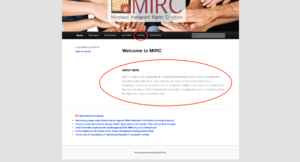
After looking on a cellphone of the same site, everything fit perfectly, as if that was the reason for the layout decisions.

Cellphones are used on 47 times per day (Wolfe 2018). The amount of people in the United States that use the internet as of 2011 is 245 million, 78.2% of the population (CNN 2011). Today, internet users are growing at a rate of about 200% worldwide (Popular Mechanics 2019). After looking at MIRC’s multiple times, it’s hard to view the website as a good fit for cellphones. It ‘s hard to imagine someone walking down the street or killing time by reading about the website. It appears more fit for a computer or laptop if the audience was in the mindset of learning more about the organization or getting involved, maybe if they went to a library. The author had the right mindset with appealing to the most popular medium for viewing content, but when people are mostly on social media apps or games on cellphones, and app should’ve been made to truly make the organization cellphone friendlier.
The website is non-profit, educational and political. The tabs under the “Resources” button are all materials for education to the audience.

The conflict in general transcends political barriers, and the organization itself is non-profit. A good way to describe MIRC is: a small organization wanting people to donate money and their time to help immigrants in need in America. Even though the web design is not extremely similar to other non-profit organizations, its text is similar: giving information regarding the organization’s mission to help a certain group of people, the people they are helping, and how to help.
This non-profit organization does not follow the typical web design setup that other organizations have when it comes to how their web pages are structured. It looks old fashioned with the general setup of: title of organization at the top of the webpage (but centered), a picture/looped video representing the organization, and a donate button.

But nothing pops out showing its targeted audience. The assumption is that being an organization that requires donors, the primary audience is probably donors or volunteers. Now, this conclusion only comes from prior knowledge of other non-profit organization website structures. With MIRC’s, there’s nothing making donations stand out. No colored button, no size difference, nothing. But being non-profit, all outside money is important. I can guess that the donor/volunteer audience is specified highly towards Democrats or Anti-Trump people. This is due to many articles or hyperlinks leading to text that speaks out against the Trump administration.

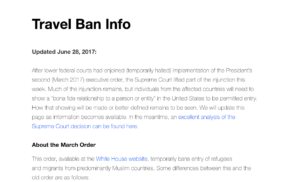


The second purpose to reach audiences and secondary audience type are people who want to be educated on the topic at hand. Lots of tabs under “Resources” talk about immigration and issues present such as Immigration 101.
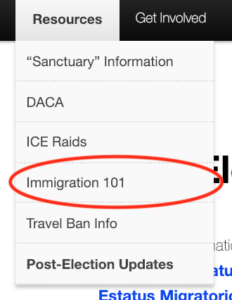
The hope with these targeted audiences is that they are humanitarian, hard-working, and/or sympathetic so they donate money and/or time towards helping immigrants.
MIRC gives lots of information pertaining immigrants living in America and the challenges they face. The author tries to pull at contemporary issues to encourage the audience to donate money and/or time talking about topics such as Trump’s administration and ICE Raids (articles found under the “Resources” button).
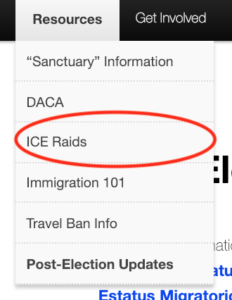
This point can be seen through a video found under the “Immigration 101” button within the “Resources” button…
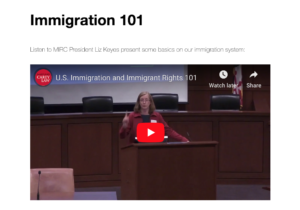
…through any number of “Resource” button tabs, or by clicking on hyperlinks found at the bottom of any page.


However, there are minimal unique ways of interacting with the web browser, or eye popping ways to gain the attention of the reader. Little is done with the use of photos, gifs, or anything that is popular now-a-days. Things appear out of date. This can also be seen with multiple articles dates being nearly 2 years old.



The purpose for this organization is to encourage its audience to give money or help out immigrants and to educate them on current issues. This can be seen through all information on the home screen: the “About MIRC” for the organization, the “Donate” button, the “Resources” button, and “Past Events” button seeing what the organization has done before.

A lot of the site is speculation. This is a combination of everything that has been looked at: author, audience, context, and genre. The author is a non-profit organization meaning the want donations from people. The targeted audience are people who would be willing to help immigrants. The most prominent genre present educational and non-profit, and the context is about immigrant’s issues today. It’s not easy to find quick answers to questions on this website. By searching through the site taking many steps, answers are there.
Though looking through the website, it’s hard to come away with an author for the site other than MIRC. No descriptions are given for the board members (found under Join MIRC).
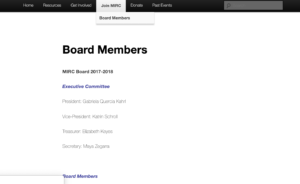
There is no reputation for the work the organization does. It makes it really hard to rely on this organization and trust them if there’s nothing credible to their work. The only thing credible is looking up board members and understanding they are actual people with solid background checks but even then it’s not clear whether they are credible enough for donations.
The website is not a good representation for an organization wanting to help immigrants. MIRC needs to update its website like other non-profit organizations to first give it more credibility from first impressions. Then, add more information to its board members so the audience is aware of their personal background and understand who runs the organization. Adding some more photos, videos, or other ways for the audience to interact with the site make its more attracting. For this organization to thrive, it needs to stay up to date with the norms for its website: creating different layouts when viewing the website on cellphones and laptops, updating website layouts so they are not out of date and appear sketchy, and add more aesthetically pleasing colors instead of faded ones that aren’t eye catching. First impressions are everything and MIRC needs to adjust there’s.
References
“The Death of the Internet.” Popular Mechanics, 7 Feb. 2019, https://www.pop- ularmechanics.com/technology/infrastructure/a26016334/death-of-the- internet/. Accessed 9 Feb. 2019.
MIRC – Maryland Immigrant Rights Coalition. Maryland Immigrant Rights Coalition, 2017, http://marylandimmigrantrightscoalition.org/. Accessed 9 Feb. 2019.
“Where is the Internet most popular?” CNN, 19 Aug. 2011, http://www.cnn.c- om/2011/WORLD/africa/08/18/country.comparisons.internet.use/index.html. Accessed 9, Feb. 2019.
Wolfe, Anselee. “Guess how often you use your phone everyday.” Journal of Accountancy, 2 Apr. 2018, https://www.journalofaccountancy.com/newslet- ters/2018/apr/how-often-use-phone-every-day.html. Accessed 9 Feb. 2019.